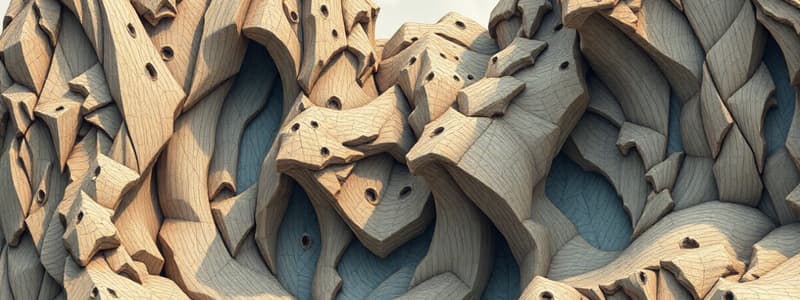Podcast
Questions and Answers
Which of the following geological processes is LEAST likely to directly induce the formation of folds in rock layers?
Which of the following geological processes is LEAST likely to directly induce the formation of folds in rock layers?
- Motion along faults
- Sediment deposition (correct)
- Regional subsidence or uplift
- Ductile flow
In a series of folded rock layers, what does the 'axial surface' represent?
In a series of folded rock layers, what does the 'axial surface' represent?
- A single surface showing the areas of different types of rock after folding
- The zone where rocks all have a relatively constant dip
- The plane connecting hinge lines of multiple layers, separating regions of differing dip (correct)
- The line of maximum curvature on a single folded layer
What is the primary distinction between a cylindrical and a non-cylindrical fold?
What is the primary distinction between a cylindrical and a non-cylindrical fold?
- The temperature at which the fold was formed
- The angle of the fold limbs
- The variation in orientation of the fold axis (correct)
- The type of rock involved in folding
Under what conditions are ductile folds, such as those found in meta-greywacke in New Zealand, most likely to form?
Under what conditions are ductile folds, such as those found in meta-greywacke in New Zealand, most likely to form?
Which of the following statements best describes a 'fold limb'?
Which of the following statements best describes a 'fold limb'?
Which of the following best describes how a new axial surface orientation is formed when axial surfaces converge, assuming consistent layer thickness?
Which of the following best describes how a new axial surface orientation is formed when axial surfaces converge, assuming consistent layer thickness?
What is the primary criterion used in the Ramsay classification of folds to categorize different fold types?
What is the primary criterion used in the Ramsay classification of folds to categorize different fold types?
In the context of fold classification, what distinguishes Class 1B folds from Class 2 folds?
In the context of fold classification, what distinguishes Class 1B folds from Class 2 folds?
What key characteristic differentiates harmonic folds from disharmonic folds in layered rock sequences?
What key characteristic differentiates harmonic folds from disharmonic folds in layered rock sequences?
Considering fold geometry, what is essential for uniquely describing a given fold?
Considering fold geometry, what is essential for uniquely describing a given fold?
In a series of parasitic folds, what does the asymmetry of these folds indicate?
In a series of parasitic folds, what does the asymmetry of these folds indicate?
If you observe a series of dextral 'Z' folds in an outcrop, what can you infer about the larger fold structure?
If you observe a series of dextral 'Z' folds in an outcrop, what can you infer about the larger fold structure?
How does a syncline differ from an anticline in terms of rock age and curvature?
How does a syncline differ from an anticline in terms of rock age and curvature?
In a map view of a plunging syncline, how would the hinge line appear?
In a map view of a plunging syncline, how would the hinge line appear?
What characterizes disharmonic folds, such as those observed in Barnhardt Canyon?
What characterizes disharmonic folds, such as those observed in Barnhardt Canyon?
What is the significance of the fold hinge line (or fold axis) in structural geology?
What is the significance of the fold hinge line (or fold axis) in structural geology?
In an inclined fold, how are the axial plane and limbs oriented?
In an inclined fold, how are the axial plane and limbs oriented?
What factor primarily contributes to the formation of folds with varying styles and geometries, such as those seen in interbedded limestones and marls?
What factor primarily contributes to the formation of folds with varying styles and geometries, such as those seen in interbedded limestones and marls?
What key geometric characteristic distinguishes a cylindrical fold from a non-cylindrical fold?
What key geometric characteristic distinguishes a cylindrical fold from a non-cylindrical fold?
The interlimb angle of a fold is used to describe what property?
The interlimb angle of a fold is used to describe what property?
Which list accurately describes fold tightness with respect to interlimb angles?
Which list accurately describes fold tightness with respect to interlimb angles?
What is the primary difference between circular and elliptical curved-hinge folds?
What is the primary difference between circular and elliptical curved-hinge folds?
Under what conditions do angular-hinge folds, such as chevron folds, typically form?
Under what conditions do angular-hinge folds, such as chevron folds, typically form?
What is a key characteristic of kink bands, and in what type of rock formations do they typically occur?
What is a key characteristic of kink bands, and in what type of rock formations do they typically occur?
How does the orientation of the hinge line differ between synclinal and anticlinal folds in both parallel and non-parallel fold systems?
How does the orientation of the hinge line differ between synclinal and anticlinal folds in both parallel and non-parallel fold systems?
Which of the following factors is least important when initially classifying a fold as either cylindrical or non-cylindrical?
Which of the following factors is least important when initially classifying a fold as either cylindrical or non-cylindrical?
Flashcards
Folds (Geology)
Folds (Geology)
Bends or flexures in layered rock, formed by motion along faults, diapirism, compaction, ductile flow, or regional subsidence/uplift.
Fold Limb (Dip Domain)
Fold Limb (Dip Domain)
Area where rocks have a relatively constant dip within a fold.
Hinge Line
Hinge Line
Line of maximum curvature on a fold; parallel to the fold axis in cylindrical folds.
Axial Surface
Axial Surface
Signup and view all the flashcards
Axial Surface Intersection
Axial Surface Intersection
Signup and view all the flashcards
Folds with Common Axial Surface
Folds with Common Axial Surface
Signup and view all the flashcards
Ramsay Fold Classification
Ramsay Fold Classification
Signup and view all the flashcards
Harmonic Folding
Harmonic Folding
Signup and view all the flashcards
Disharmonic Folding
Disharmonic Folding
Signup and view all the flashcards
Non-Cylindrical Folds
Non-Cylindrical Folds
Signup and view all the flashcards
Interlimb Angle
Interlimb Angle
Signup and view all the flashcards
Gentle Fold
Gentle Fold
Signup and view all the flashcards
Open Fold
Open Fold
Signup and view all the flashcards
Tight Fold
Tight Fold
Signup and view all the flashcards
Isoclinal Fold
Isoclinal Fold
Signup and view all the flashcards
Angular-Hinge Folds
Angular-Hinge Folds
Signup and view all the flashcards
Kink Bands
Kink Bands
Signup and view all the flashcards
Parasitic/Subsidiary Folds
Parasitic/Subsidiary Folds
Signup and view all the flashcards
Dextral "Z" Folds
Dextral "Z" Folds
Signup and view all the flashcards
Sinistral "S" Folds
Sinistral "S" Folds
Signup and view all the flashcards
Asymmetry of Parasitic Folds
Asymmetry of Parasitic Folds
Signup and view all the flashcards
Anticline
Anticline
Signup and view all the flashcards
Syncline
Syncline
Signup and view all the flashcards
Plunging Anticline
Plunging Anticline
Signup and view all the flashcards
Plunging Syncline
Plunging Syncline
Signup and view all the flashcards
Study Notes
- Folds are bends/flexures in layered rock, responding to motion along faults, diapirism, compaction, ductile flow, and/or regional subsidence/uplift.
- Folds are expressed as dipping features corresponding to inclined foliations, such as stratigraphic bedding.
- Ductile folds form under high temperature and pressure conditions in meta-greywacke areas like New Zealand.
Fold Terminology
- Fold Limb (dip domain): Area where rocks have a relatively constant dip.
- Fold Axis/Hinge: Location of maximum curvature that separates limbs.
- Hinge Line: Line of maximum curvature on a fold, parallel to the fold axis in cylindrical folds.
- Axial Surface: Plane connecting hinge lines for different layers, separating regions of different dip.
Cylindrical vs. Non-Cylindrical Folds
- Cylindrical Fold: Describable geometrically by passing a line (fold hinge line) parallel to itself through space without rotation/distortion.
- Non-Cylindrical Fold: Rotation/distortion of a line is necessary to trace the fold's form.
Fold Tightness
- Unfolded: 180° interlimb angle
- Gentle: 170-180° interlimb angle
- Open: 90-170° interlimb angle
- Tight: 10-90° interlimb angle
- Isoclinal: 0-10° interlimb angle
Fold Curvature
- Curved-Hinge Folds include Circular and Elliptical types.
- Angular-Hinge Folds include Chevron and Box types.
- An example of folding under moderately-low pressure and temperature conditions in interbedded shales and limestones can be seen in Kaikoura, New Zealand, demonstrating Angular Chevron Folds.
- Kink Bands: Parallel folding with parallel axial surfaces in well-bedded rocks which are thin with high contrast layers.
Intersection of Axial Surfaces
- Axial surfaces converge, forming a new axial surface orientation that bisects the angle when layer thickness is maintained, typically in map-scale structures under low to moderate pressure/temperature.
Characterizing Folds
- Characterization requires defining axial surface and hinge line orientation to uniquely describe folds.
- Classification by Dip: Folds are classified by the dip of the hinge and axial surface.
- Fold are classified as Upright, Inclined, or Recumbent, and Horizontal or Plunging.
Ramsay Classification
- Dip Isogons: Lines connecting equal dip points between top and bottom layers, used to classify fold type.
- Class 1: Inner curvature is greater than outer curvature.
- Class 1A folds are rare.
- Class 1B folds are common in low-temperature folding dominated by flexural slip-parallel layers.
- Class 1C folds are common in competent layers deformed at high temperatures.
- Class 2: Inner curvature equals outer curvature.
- Class 2 folds are common in rocks with low ductility contrasts folded by passive amplification-parallel isogons.
- Class 3: Outer curvature is greater than inner curvature, common in weak layers deformed at high temperature.
Fold Mechanics
- Layer-Active Folding includes buckling and bending.
- Layer-Passive Folding includes passive amplification.
Harmonic vs. Disharmonic Folding
- Harmonic Folding: No (or very gradual) changes in fold shape between successive layers, "in phase".
- Disharmonic Folding: Pronounced changes in fold shape between successive layers.
- The Canadian Rockies exhibit an example of harmonic folding.
- The Barbastro Anticline in Aragon, Spain shows disharmonic folds in layered carbonates and evaporites in its core.
Parasitic Folds
- Parasitic/Subsidiary Folds: Minor folds developing on a larger fold's flank, reflecting the fold limb's overall shear sense.
- Dextral "Z" folds and Sinistral "S" folds are examples of Parasitic folds.
- The asymmetry of parasitic folds points toward the crest of the larger fold.
Anticlines and Synclines
- Anticline: Concave downward, with the oldest rocks in the center.
- Syncline: Concave upward, with the youngest rocks in the center.
Studying That Suits You
Use AI to generate personalized quizzes and flashcards to suit your learning preferences.



